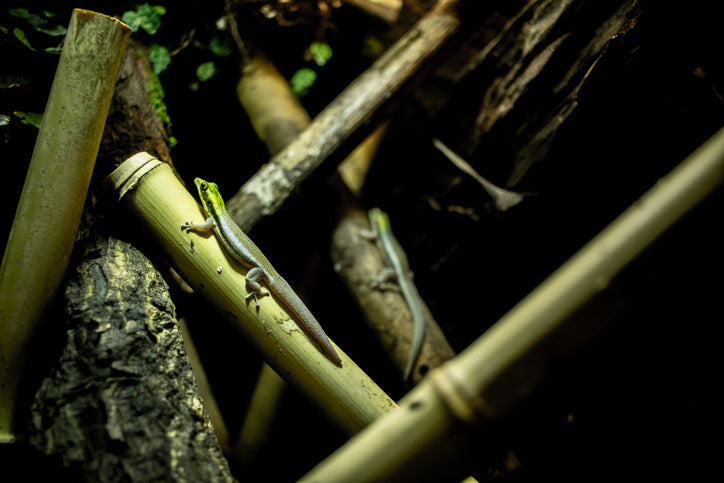Neon Day Gecko (Phelsuma klemmeri) Care Sheet
Quick Facts
Scientific Name: Phelsuma klemmeri
Common Names: Neon Day Gecko
Origin: Madagascar
Adult Size: 10–12 cm (4–5 inches) total length
Lifespan: 6–10 years in captivity
Sex Differences: Males are slightly larger, with brighter colours and visible hemipenal bulges; females are smaller and slightly duller in coloration
Beginner Suitability: Moderate – small, active geckos that require precise temperature, humidity, and diet
Enclosure
Size: A pair or small group can be housed in a vertical enclosure measuring 30 cm x 30 cm x 45 cm (12 x 12 x 18 inches). Larger enclosures are preferred to allow climbing and enrichment. Juveniles can be housed in smaller enclosures initially but must be upgraded as they grow.
Substrate: Use moisture-retaining substrates such as coconut fibre, orchid bark, or bioactive soil. Avoid sand or loose substrates that may cause impaction.
Hides: Provide multiple hiding spots and vertical climbing surfaces using live or artificial plants, cork bark, or leaf litter. Include basking spots at different heights.
Heating: Maintain a hot spot of 28–30°C and a cooler side of 22–24°C. Night temperatures can safely drop to 20–22°C. Use ceramic heat emitters or low-wattage heat bulbs regulated with a thermostat.
Lighting: Provide full-spectrum lighting and low-level UVB (2–5%) to promote health and natural behaviour. Maintain a 12-hour light / 12-hour dark cycle.
Humidity: Maintain 60–80% humidity. Mist daily or provide automated misting. Ensure proper ventilation to prevent mould.
Diet
Primary Diet Type: Omnivore
Food Items: Feed small insects such as fruit flies, pinhead crickets, and small roaches. Supplement with pureed fruit, commercial gecko diet powders, or nectar solutions. Juveniles require higher protein intake.
Feeding Frequency: Juveniles daily; adults every 1–2 days. Dust insects with calcium at every feeding and a multivitamin supplement once per week.
Feeding Troubleshooting: Ensure insects are appropriately sized. Offer variety to encourage feeding. Remove uneaten food to prevent stress or mould.
Water
Provide a shallow water dish with fresh water. Frogs and geckos may also drink droplets from misted surfaces.
Behavior And Handling
Neon Day Geckos are active and fast-moving. They can be skittish, so handle gently and support the full body. They are best kept in compatible pairs or small groups with careful monitoring.
Enrichment
Include branches, plants, and vertical climbing surfaces. Provide hiding spots at multiple heights. Rearrange décor occasionally to encourage exploration and natural behaviours.
Health
Signs of illness include lethargy, refusal to eat, abnormal stool, retained shed, or swelling. Maintain proper temperature, humidity, and diet. Consult a reptile-specialist veterinarian if issues persist.
Lifespan
Typically 6–10 years in captivity with proper care.
Legality In The UK
Neon Day Geckos are legal to keep in the UK. No licence is required for private ownership. Owners must comply with Welfare of Animals regulations.
Difficulty Bars (Relative)
| Category | Level |
|---|---|
| Feeding | ████▁ Moderate (requires small insects and fruit/nectar supplementation) |
| Handling | █▁▁▁▁ Very Low (fast, skittish species) |
| Humidity Needs | █████ High (maintain 60–80%) |
| Enclosure Setup | █████ High (vertical space and hides essential) |
| Beginner Suitability | ███▁▁ Moderate (good for attentive beginners) |

